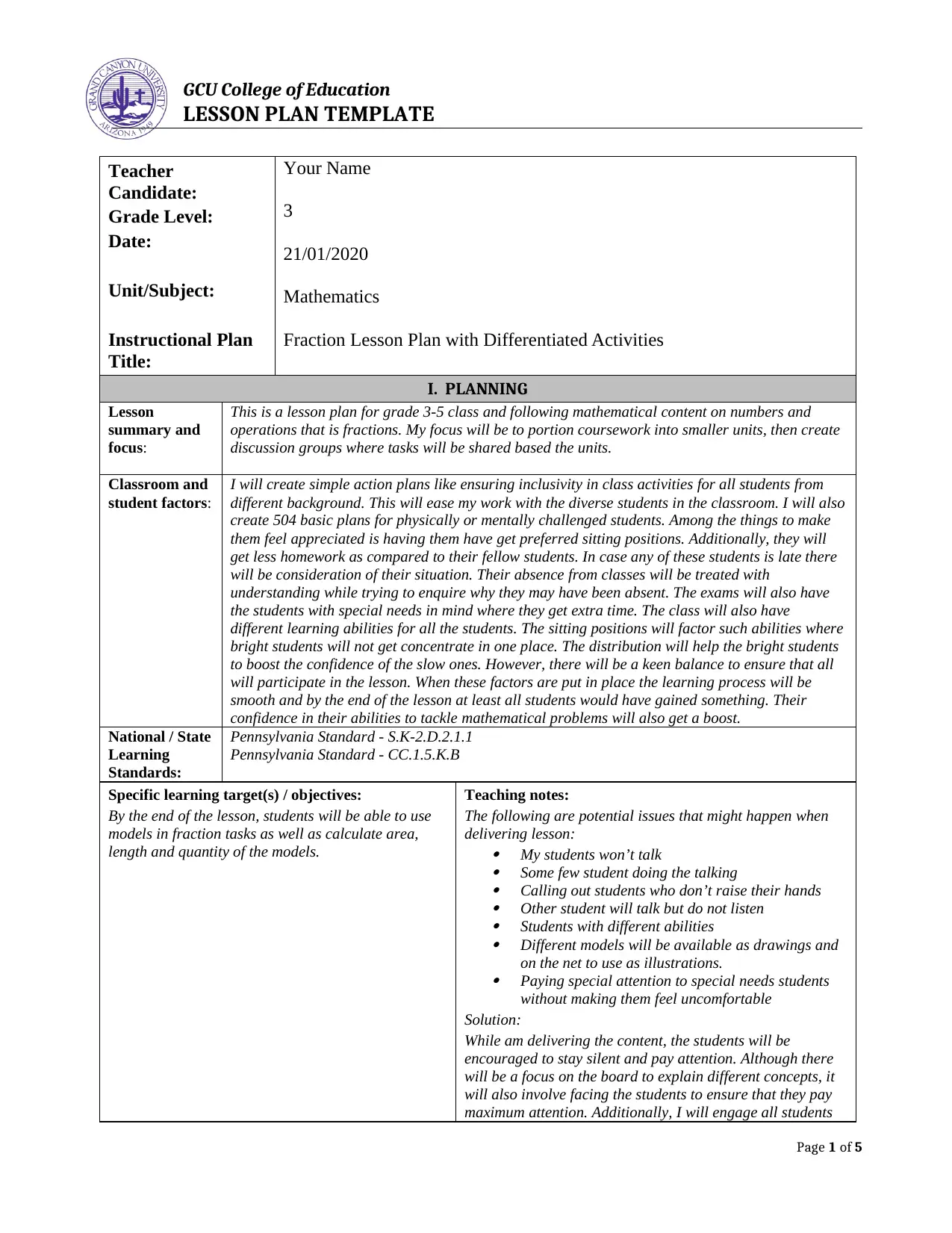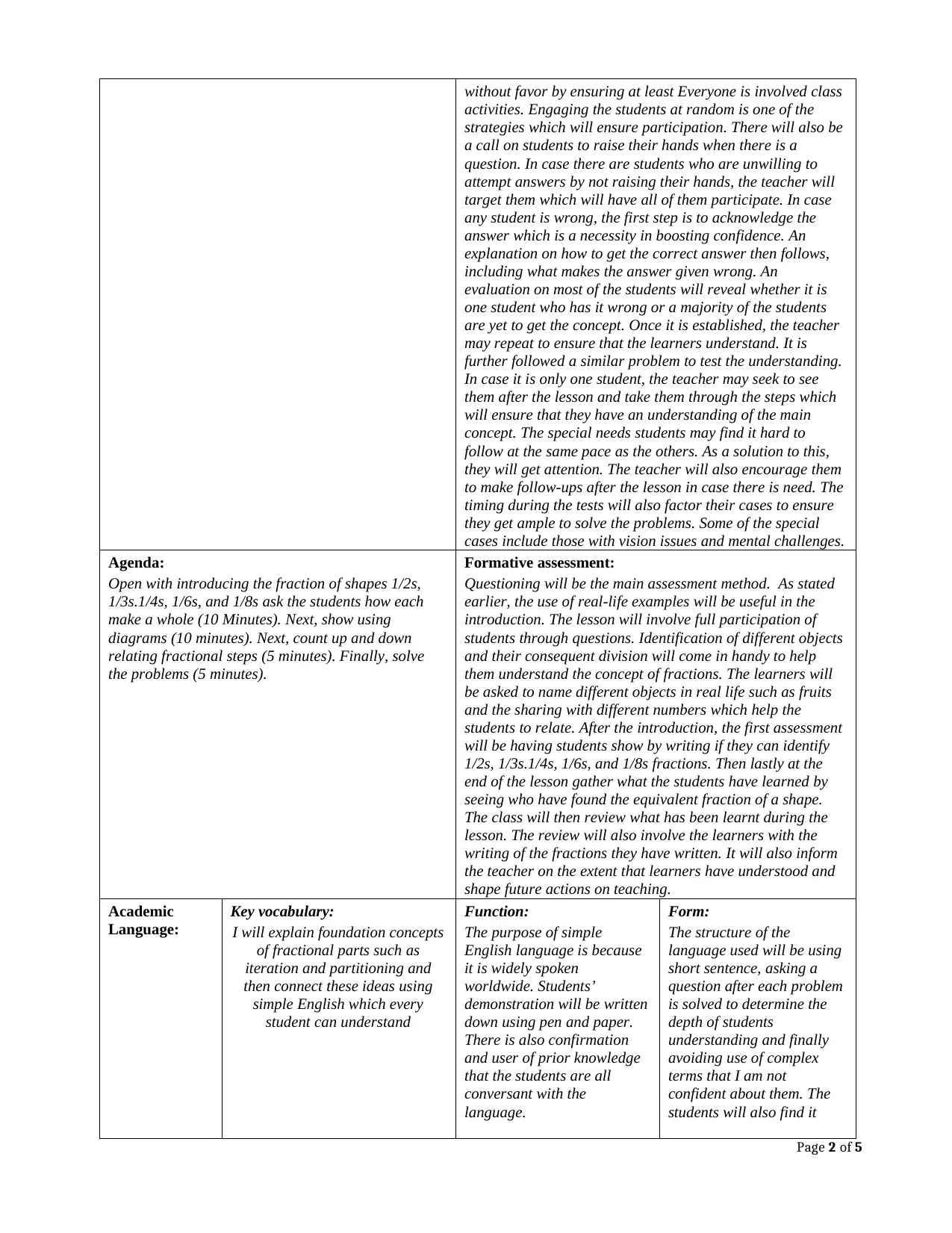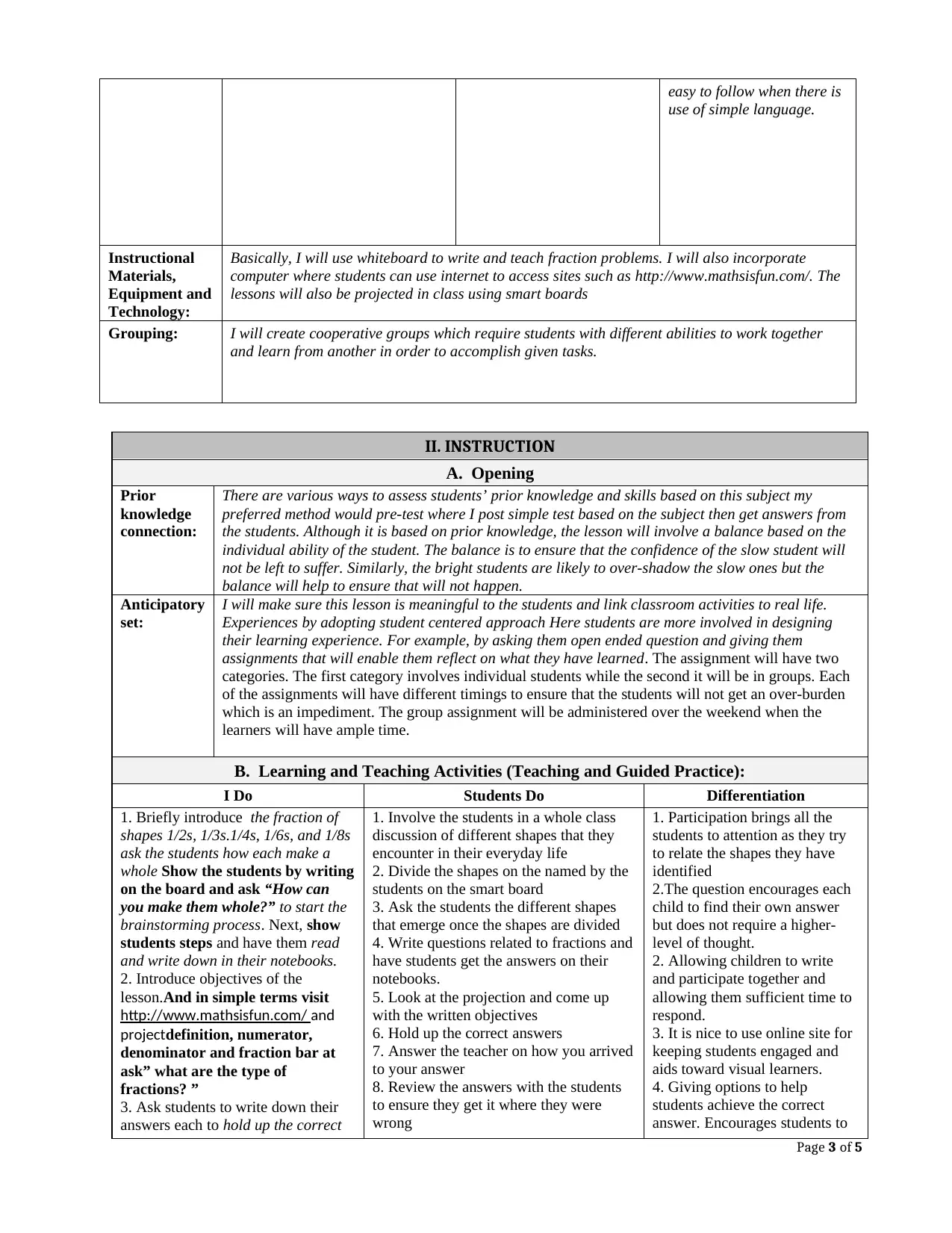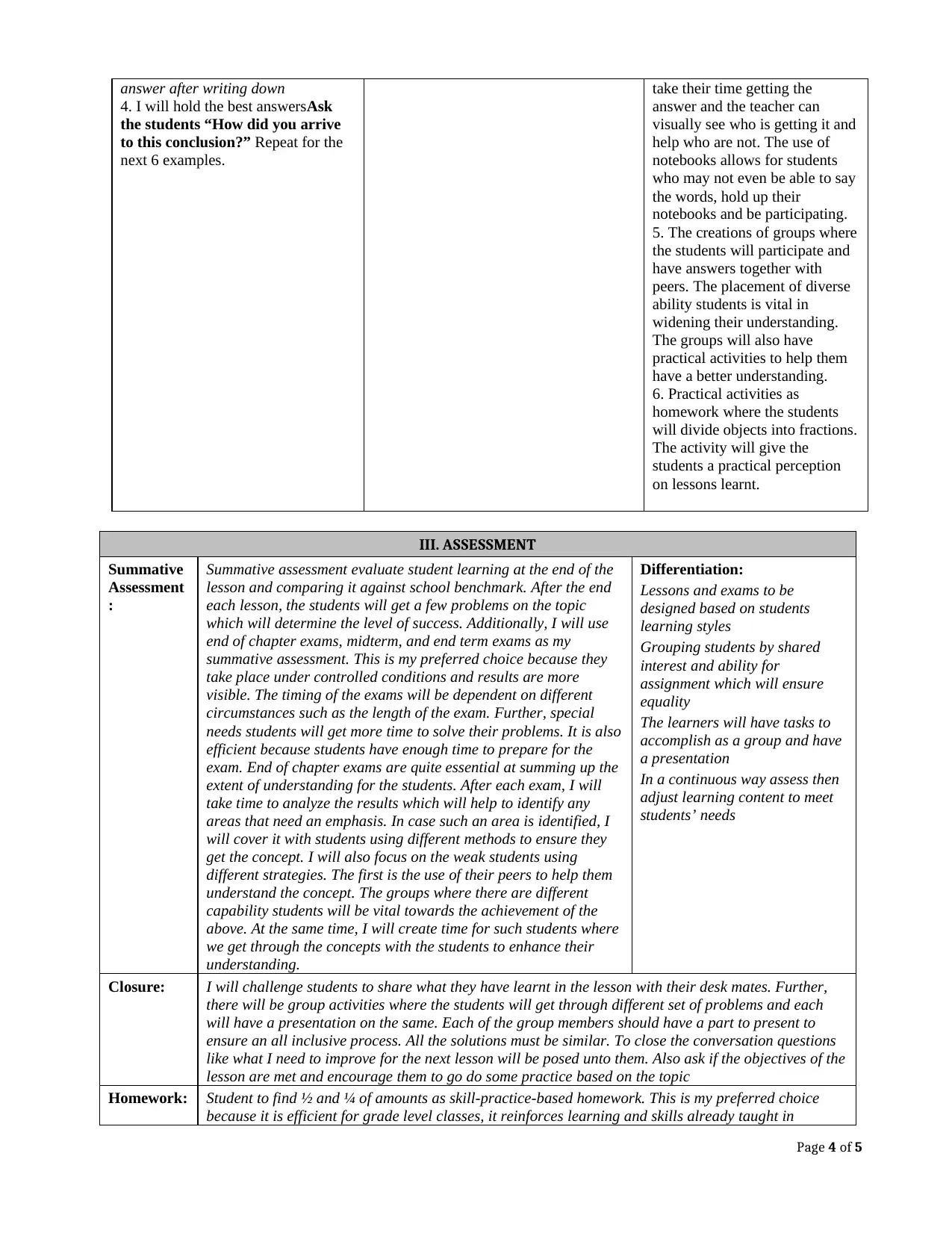GCU College of Education | Assignment
VerifiedAdded on 2022/08/21
|5
|2504
|32
AI Summary
Contribute Materials
Your contribution can guide someone’s learning journey. Share your
documents today.

GCU College of Education
LESSON PLAN TEMPLATE
Teacher
Candidate:
Grade Level:
Date:
Unit/Subject:
Instructional Plan
Title:
Your Name
3
21/01/2020
Mathematics
Fraction Lesson Plan with Differentiated Activities
I. PLANNING
Lesson
summary and
focus:
This is a lesson plan for grade 3-5 class and following mathematical content on numbers and
operations that is fractions. My focus will be to portion coursework into smaller units, then create
discussion groups where tasks will be shared based the units.
Classroom and
student factors:
I will create simple action plans like ensuring inclusivity in class activities for all students from
different background. This will ease my work with the diverse students in the classroom. I will also
create 504 basic plans for physically or mentally challenged students. Among the things to make
them feel appreciated is having them have get preferred sitting positions. Additionally, they will
get less homework as compared to their fellow students. In case any of these students is late there
will be consideration of their situation. Their absence from classes will be treated with
understanding while trying to enquire why they may have been absent. The exams will also have
the students with special needs in mind where they get extra time. The class will also have
different learning abilities for all the students. The sitting positions will factor such abilities where
bright students will not get concentrate in one place. The distribution will help the bright students
to boost the confidence of the slow ones. However, there will be a keen balance to ensure that all
will participate in the lesson. When these factors are put in place the learning process will be
smooth and by the end of the lesson at least all students would have gained something. Their
confidence in their abilities to tackle mathematical problems will also get a boost.
National / State
Learning
Standards:
Pennsylvania Standard - S.K-2.D.2.1.1
Pennsylvania Standard - CC.1.5.K.B
Specific learning target(s) / objectives:
By the end of the lesson, students will be able to use
models in fraction tasks as well as calculate area,
length and quantity of the models.
Teaching notes:
The following are potential issues that might happen when
delivering lesson:
My students won’t talk
Some few student doing the talking
Calling out students who don’t raise their hands
Other student will talk but do not listen
Students with different abilities
Different models will be available as drawings and
on the net to use as illustrations.
Paying special attention to special needs students
without making them feel uncomfortable
Solution:
While am delivering the content, the students will be
encouraged to stay silent and pay attention. Although there
will be a focus on the board to explain different concepts, it
will also involve facing the students to ensure that they pay
maximum attention. Additionally, I will engage all students
Page 1 of 5
LESSON PLAN TEMPLATE
Teacher
Candidate:
Grade Level:
Date:
Unit/Subject:
Instructional Plan
Title:
Your Name
3
21/01/2020
Mathematics
Fraction Lesson Plan with Differentiated Activities
I. PLANNING
Lesson
summary and
focus:
This is a lesson plan for grade 3-5 class and following mathematical content on numbers and
operations that is fractions. My focus will be to portion coursework into smaller units, then create
discussion groups where tasks will be shared based the units.
Classroom and
student factors:
I will create simple action plans like ensuring inclusivity in class activities for all students from
different background. This will ease my work with the diverse students in the classroom. I will also
create 504 basic plans for physically or mentally challenged students. Among the things to make
them feel appreciated is having them have get preferred sitting positions. Additionally, they will
get less homework as compared to their fellow students. In case any of these students is late there
will be consideration of their situation. Their absence from classes will be treated with
understanding while trying to enquire why they may have been absent. The exams will also have
the students with special needs in mind where they get extra time. The class will also have
different learning abilities for all the students. The sitting positions will factor such abilities where
bright students will not get concentrate in one place. The distribution will help the bright students
to boost the confidence of the slow ones. However, there will be a keen balance to ensure that all
will participate in the lesson. When these factors are put in place the learning process will be
smooth and by the end of the lesson at least all students would have gained something. Their
confidence in their abilities to tackle mathematical problems will also get a boost.
National / State
Learning
Standards:
Pennsylvania Standard - S.K-2.D.2.1.1
Pennsylvania Standard - CC.1.5.K.B
Specific learning target(s) / objectives:
By the end of the lesson, students will be able to use
models in fraction tasks as well as calculate area,
length and quantity of the models.
Teaching notes:
The following are potential issues that might happen when
delivering lesson:
My students won’t talk
Some few student doing the talking
Calling out students who don’t raise their hands
Other student will talk but do not listen
Students with different abilities
Different models will be available as drawings and
on the net to use as illustrations.
Paying special attention to special needs students
without making them feel uncomfortable
Solution:
While am delivering the content, the students will be
encouraged to stay silent and pay attention. Although there
will be a focus on the board to explain different concepts, it
will also involve facing the students to ensure that they pay
maximum attention. Additionally, I will engage all students
Page 1 of 5
Secure Best Marks with AI Grader
Need help grading? Try our AI Grader for instant feedback on your assignments.

without favor by ensuring at least Everyone is involved class
activities. Engaging the students at random is one of the
strategies which will ensure participation. There will also be
a call on students to raise their hands when there is a
question. In case there are students who are unwilling to
attempt answers by not raising their hands, the teacher will
target them which will have all of them participate. In case
any student is wrong, the first step is to acknowledge the
answer which is a necessity in boosting confidence. An
explanation on how to get the correct answer then follows,
including what makes the answer given wrong. An
evaluation on most of the students will reveal whether it is
one student who has it wrong or a majority of the students
are yet to get the concept. Once it is established, the teacher
may repeat to ensure that the learners understand. It is
further followed a similar problem to test the understanding.
In case it is only one student, the teacher may seek to see
them after the lesson and take them through the steps which
will ensure that they have an understanding of the main
concept. The special needs students may find it hard to
follow at the same pace as the others. As a solution to this,
they will get attention. The teacher will also encourage them
to make follow-ups after the lesson in case there is need. The
timing during the tests will also factor their cases to ensure
they get ample to solve the problems. Some of the special
cases include those with vision issues and mental challenges.
Agenda:
Open with introducing the fraction of shapes 1/2s,
1/3s.1/4s, 1/6s, and 1/8s ask the students how each
make a whole (10 Minutes). Next, show using
diagrams (10 minutes). Next, count up and down
relating fractional steps (5 minutes). Finally, solve
the problems (5 minutes).
Formative assessment:
Questioning will be the main assessment method. As stated
earlier, the use of real-life examples will be useful in the
introduction. The lesson will involve full participation of
students through questions. Identification of different objects
and their consequent division will come in handy to help
them understand the concept of fractions. The learners will
be asked to name different objects in real life such as fruits
and the sharing with different numbers which help the
students to relate. After the introduction, the first assessment
will be having students show by writing if they can identify
1/2s, 1/3s.1/4s, 1/6s, and 1/8s fractions. Then lastly at the
end of the lesson gather what the students have learned by
seeing who have found the equivalent fraction of a shape.
The class will then review what has been learnt during the
lesson. The review will also involve the learners with the
writing of the fractions they have written. It will also inform
the teacher on the extent that learners have understood and
shape future actions on teaching.
Academic
Language:
Key vocabulary:
I will explain foundation concepts
of fractional parts such as
iteration and partitioning and
then connect these ideas using
simple English which every
student can understand
Function:
The purpose of simple
English language is because
it is widely spoken
worldwide. Students’
demonstration will be written
down using pen and paper.
There is also confirmation
and user of prior knowledge
that the students are all
conversant with the
language.
Form:
The structure of the
language used will be using
short sentence, asking a
question after each problem
is solved to determine the
depth of students
understanding and finally
avoiding use of complex
terms that I am not
confident about them. The
students will also find it
Page 2 of 5
activities. Engaging the students at random is one of the
strategies which will ensure participation. There will also be
a call on students to raise their hands when there is a
question. In case there are students who are unwilling to
attempt answers by not raising their hands, the teacher will
target them which will have all of them participate. In case
any student is wrong, the first step is to acknowledge the
answer which is a necessity in boosting confidence. An
explanation on how to get the correct answer then follows,
including what makes the answer given wrong. An
evaluation on most of the students will reveal whether it is
one student who has it wrong or a majority of the students
are yet to get the concept. Once it is established, the teacher
may repeat to ensure that the learners understand. It is
further followed a similar problem to test the understanding.
In case it is only one student, the teacher may seek to see
them after the lesson and take them through the steps which
will ensure that they have an understanding of the main
concept. The special needs students may find it hard to
follow at the same pace as the others. As a solution to this,
they will get attention. The teacher will also encourage them
to make follow-ups after the lesson in case there is need. The
timing during the tests will also factor their cases to ensure
they get ample to solve the problems. Some of the special
cases include those with vision issues and mental challenges.
Agenda:
Open with introducing the fraction of shapes 1/2s,
1/3s.1/4s, 1/6s, and 1/8s ask the students how each
make a whole (10 Minutes). Next, show using
diagrams (10 minutes). Next, count up and down
relating fractional steps (5 minutes). Finally, solve
the problems (5 minutes).
Formative assessment:
Questioning will be the main assessment method. As stated
earlier, the use of real-life examples will be useful in the
introduction. The lesson will involve full participation of
students through questions. Identification of different objects
and their consequent division will come in handy to help
them understand the concept of fractions. The learners will
be asked to name different objects in real life such as fruits
and the sharing with different numbers which help the
students to relate. After the introduction, the first assessment
will be having students show by writing if they can identify
1/2s, 1/3s.1/4s, 1/6s, and 1/8s fractions. Then lastly at the
end of the lesson gather what the students have learned by
seeing who have found the equivalent fraction of a shape.
The class will then review what has been learnt during the
lesson. The review will also involve the learners with the
writing of the fractions they have written. It will also inform
the teacher on the extent that learners have understood and
shape future actions on teaching.
Academic
Language:
Key vocabulary:
I will explain foundation concepts
of fractional parts such as
iteration and partitioning and
then connect these ideas using
simple English which every
student can understand
Function:
The purpose of simple
English language is because
it is widely spoken
worldwide. Students’
demonstration will be written
down using pen and paper.
There is also confirmation
and user of prior knowledge
that the students are all
conversant with the
language.
Form:
The structure of the
language used will be using
short sentence, asking a
question after each problem
is solved to determine the
depth of students
understanding and finally
avoiding use of complex
terms that I am not
confident about them. The
students will also find it
Page 2 of 5

easy to follow when there is
use of simple language.
Instructional
Materials,
Equipment and
Technology:
Basically, I will use whiteboard to write and teach fraction problems. I will also incorporate
computer where students can use internet to access sites such as http://www.mathsisfun.com/. The
lessons will also be projected in class using smart boards
Grouping: I will create cooperative groups which require students with different abilities to work together
and learn from another in order to accomplish given tasks.
II. INSTRUCTION
A. Opening
Prior
knowledge
connection:
There are various ways to assess students’ prior knowledge and skills based on this subject my
preferred method would pre-test where I post simple test based on the subject then get answers from
the students. Although it is based on prior knowledge, the lesson will involve a balance based on the
individual ability of the student. The balance is to ensure that the confidence of the slow student will
not be left to suffer. Similarly, the bright students are likely to over-shadow the slow ones but the
balance will help to ensure that will not happen.
Anticipatory
set:
I will make sure this lesson is meaningful to the students and link classroom activities to real life.
Experiences by adopting student centered approach Here students are more involved in designing
their learning experience. For example, by asking them open ended question and giving them
assignments that will enable them reflect on what they have learned. The assignment will have two
categories. The first category involves individual students while the second it will be in groups. Each
of the assignments will have different timings to ensure that the students will not get an over-burden
which is an impediment. The group assignment will be administered over the weekend when the
learners will have ample time.
B. Learning and Teaching Activities (Teaching and Guided Practice):
I Do Students Do Differentiation
1. Briefly introduce the fraction of
shapes 1/2s, 1/3s.1/4s, 1/6s, and 1/8s
ask the students how each make a
whole Show the students by writing
on the board and ask “How can
you make them whole?” to start the
brainstorming process. Next, show
students steps and have them read
and write down in their notebooks.
2. Introduce objectives of the
lesson.And in simple terms visit
http://www.mathsisfun.com/ and
projectdefinition, numerator,
denominator and fraction bar at
ask” what are the type of
fractions? ”
3. Ask students to write down their
answers each to hold up the correct
1. Involve the students in a whole class
discussion of different shapes that they
encounter in their everyday life
2. Divide the shapes on the named by the
students on the smart board
3. Ask the students the different shapes
that emerge once the shapes are divided
4. Write questions related to fractions and
have students get the answers on their
notebooks.
5. Look at the projection and come up
with the written objectives
6. Hold up the correct answers
7. Answer the teacher on how you arrived
to your answer
8. Review the answers with the students
to ensure they get it where they were
wrong
1. Participation brings all the
students to attention as they try
to relate the shapes they have
identified
2.The question encourages each
child to find their own answer
but does not require a higher-
level of thought.
2. Allowing children to write
and participate together and
allowing them sufficient time to
respond.
3. It is nice to use online site for
keeping students engaged and
aids toward visual learners.
4. Giving options to help
students achieve the correct
answer. Encourages students to
Page 3 of 5
use of simple language.
Instructional
Materials,
Equipment and
Technology:
Basically, I will use whiteboard to write and teach fraction problems. I will also incorporate
computer where students can use internet to access sites such as http://www.mathsisfun.com/. The
lessons will also be projected in class using smart boards
Grouping: I will create cooperative groups which require students with different abilities to work together
and learn from another in order to accomplish given tasks.
II. INSTRUCTION
A. Opening
Prior
knowledge
connection:
There are various ways to assess students’ prior knowledge and skills based on this subject my
preferred method would pre-test where I post simple test based on the subject then get answers from
the students. Although it is based on prior knowledge, the lesson will involve a balance based on the
individual ability of the student. The balance is to ensure that the confidence of the slow student will
not be left to suffer. Similarly, the bright students are likely to over-shadow the slow ones but the
balance will help to ensure that will not happen.
Anticipatory
set:
I will make sure this lesson is meaningful to the students and link classroom activities to real life.
Experiences by adopting student centered approach Here students are more involved in designing
their learning experience. For example, by asking them open ended question and giving them
assignments that will enable them reflect on what they have learned. The assignment will have two
categories. The first category involves individual students while the second it will be in groups. Each
of the assignments will have different timings to ensure that the students will not get an over-burden
which is an impediment. The group assignment will be administered over the weekend when the
learners will have ample time.
B. Learning and Teaching Activities (Teaching and Guided Practice):
I Do Students Do Differentiation
1. Briefly introduce the fraction of
shapes 1/2s, 1/3s.1/4s, 1/6s, and 1/8s
ask the students how each make a
whole Show the students by writing
on the board and ask “How can
you make them whole?” to start the
brainstorming process. Next, show
students steps and have them read
and write down in their notebooks.
2. Introduce objectives of the
lesson.And in simple terms visit
http://www.mathsisfun.com/ and
projectdefinition, numerator,
denominator and fraction bar at
ask” what are the type of
fractions? ”
3. Ask students to write down their
answers each to hold up the correct
1. Involve the students in a whole class
discussion of different shapes that they
encounter in their everyday life
2. Divide the shapes on the named by the
students on the smart board
3. Ask the students the different shapes
that emerge once the shapes are divided
4. Write questions related to fractions and
have students get the answers on their
notebooks.
5. Look at the projection and come up
with the written objectives
6. Hold up the correct answers
7. Answer the teacher on how you arrived
to your answer
8. Review the answers with the students
to ensure they get it where they were
wrong
1. Participation brings all the
students to attention as they try
to relate the shapes they have
identified
2.The question encourages each
child to find their own answer
but does not require a higher-
level of thought.
2. Allowing children to write
and participate together and
allowing them sufficient time to
respond.
3. It is nice to use online site for
keeping students engaged and
aids toward visual learners.
4. Giving options to help
students achieve the correct
answer. Encourages students to
Page 3 of 5

answer after writing down
4. I will hold the best answersAsk
the students “How did you arrive
to this conclusion?” Repeat for the
next 6 examples.
take their time getting the
answer and the teacher can
visually see who is getting it and
help who are not. The use of
notebooks allows for students
who may not even be able to say
the words, hold up their
notebooks and be participating.
5. The creations of groups where
the students will participate and
have answers together with
peers. The placement of diverse
ability students is vital in
widening their understanding.
The groups will also have
practical activities to help them
have a better understanding.
6. Practical activities as
homework where the students
will divide objects into fractions.
The activity will give the
students a practical perception
on lessons learnt.
III. ASSESSMENT
Summative
Assessment
:
Summative assessment evaluate student learning at the end of the
lesson and comparing it against school benchmark. After the end
each lesson, the students will get a few problems on the topic
which will determine the level of success. Additionally, I will use
end of chapter exams, midterm, and end term exams as my
summative assessment. This is my preferred choice because they
take place under controlled conditions and results are more
visible. The timing of the exams will be dependent on different
circumstances such as the length of the exam. Further, special
needs students will get more time to solve their problems. It is also
efficient because students have enough time to prepare for the
exam. End of chapter exams are quite essential at summing up the
extent of understanding for the students. After each exam, I will
take time to analyze the results which will help to identify any
areas that need an emphasis. In case such an area is identified, I
will cover it with students using different methods to ensure they
get the concept. I will also focus on the weak students using
different strategies. The first is the use of their peers to help them
understand the concept. The groups where there are different
capability students will be vital towards the achievement of the
above. At the same time, I will create time for such students where
we get through the concepts with the students to enhance their
understanding.
Differentiation:
Lessons and exams to be
designed based on students
learning styles
Grouping students by shared
interest and ability for
assignment which will ensure
equality
The learners will have tasks to
accomplish as a group and have
a presentation
In a continuous way assess then
adjust learning content to meet
students’ needs
Closure: I will challenge students to share what they have learnt in the lesson with their desk mates. Further,
there will be group activities where the students will get through different set of problems and each
will have a presentation on the same. Each of the group members should have a part to present to
ensure an all inclusive process. All the solutions must be similar. To close the conversation questions
like what I need to improve for the next lesson will be posed unto them. Also ask if the objectives of the
lesson are met and encourage them to go do some practice based on the topic
Homework: Student to find ½ and ¼ of amounts as skill-practice-based homework. This is my preferred choice
because it is efficient for grade level classes, it reinforces learning and skills already taught in
Page 4 of 5
4. I will hold the best answersAsk
the students “How did you arrive
to this conclusion?” Repeat for the
next 6 examples.
take their time getting the
answer and the teacher can
visually see who is getting it and
help who are not. The use of
notebooks allows for students
who may not even be able to say
the words, hold up their
notebooks and be participating.
5. The creations of groups where
the students will participate and
have answers together with
peers. The placement of diverse
ability students is vital in
widening their understanding.
The groups will also have
practical activities to help them
have a better understanding.
6. Practical activities as
homework where the students
will divide objects into fractions.
The activity will give the
students a practical perception
on lessons learnt.
III. ASSESSMENT
Summative
Assessment
:
Summative assessment evaluate student learning at the end of the
lesson and comparing it against school benchmark. After the end
each lesson, the students will get a few problems on the topic
which will determine the level of success. Additionally, I will use
end of chapter exams, midterm, and end term exams as my
summative assessment. This is my preferred choice because they
take place under controlled conditions and results are more
visible. The timing of the exams will be dependent on different
circumstances such as the length of the exam. Further, special
needs students will get more time to solve their problems. It is also
efficient because students have enough time to prepare for the
exam. End of chapter exams are quite essential at summing up the
extent of understanding for the students. After each exam, I will
take time to analyze the results which will help to identify any
areas that need an emphasis. In case such an area is identified, I
will cover it with students using different methods to ensure they
get the concept. I will also focus on the weak students using
different strategies. The first is the use of their peers to help them
understand the concept. The groups where there are different
capability students will be vital towards the achievement of the
above. At the same time, I will create time for such students where
we get through the concepts with the students to enhance their
understanding.
Differentiation:
Lessons and exams to be
designed based on students
learning styles
Grouping students by shared
interest and ability for
assignment which will ensure
equality
The learners will have tasks to
accomplish as a group and have
a presentation
In a continuous way assess then
adjust learning content to meet
students’ needs
Closure: I will challenge students to share what they have learnt in the lesson with their desk mates. Further,
there will be group activities where the students will get through different set of problems and each
will have a presentation on the same. Each of the group members should have a part to present to
ensure an all inclusive process. All the solutions must be similar. To close the conversation questions
like what I need to improve for the next lesson will be posed unto them. Also ask if the objectives of the
lesson are met and encourage them to go do some practice based on the topic
Homework: Student to find ½ and ¼ of amounts as skill-practice-based homework. This is my preferred choice
because it is efficient for grade level classes, it reinforces learning and skills already taught in
Page 4 of 5
Secure Best Marks with AI Grader
Need help grading? Try our AI Grader for instant feedback on your assignments.

classroom. This will promote retention of the content that is taught.
Page 5 of 5
Page 5 of 5
1 out of 5
Related Documents
Your All-in-One AI-Powered Toolkit for Academic Success.
+13062052269
info@desklib.com
Available 24*7 on WhatsApp / Email
![[object Object]](/_next/static/media/star-bottom.7253800d.svg)
Unlock your academic potential
© 2024 | Zucol Services PVT LTD | All rights reserved.





